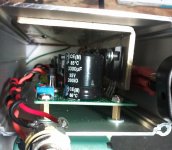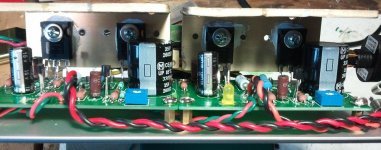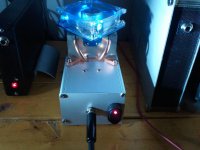First Thanks to all involved with this project..
This sounds really nice...

Its difficult to find projects with enough documentation.
The guides and pictures really help.
I used a Hammond Manufacturing 1455ZT2201 case..
and from LoudThud's recommendation, left off R1 and R3 to cut the current in half,
lower heat and power requirements. As its for headphones. I did use sockets so the
resistors can be added later..
I need to add cooling vents as it is a sealed case, and Plan to put a 80W CPU cooler on top.
internal case temp is 101F as of now...
This sounds really nice...
Its difficult to find projects with enough documentation.
The guides and pictures really help.
I used a Hammond Manufacturing 1455ZT2201 case..
and from LoudThud's recommendation, left off R1 and R3 to cut the current in half,
lower heat and power requirements. As its for headphones. I did use sockets so the
resistors can be added later..
I need to add cooling vents as it is a sealed case, and Plan to put a 80W CPU cooler on top.
internal case temp is 101F as of now...
Attachments
Has anyone ever seen ACA turbo version with parellel output mosfet?
irfp240 x 4 per channel. More than 10 watt/channel
It's very hard to drive more than one IRFP240 with a single JFET (Q4). The rise in distortion at high frequencies gets bad pretty fast, you start to see visible distortion at 1KHz, especially as you try to swing near the rail. I've had some success driving a bigger Q1 with a PNP bipolar emitter follower, but you rapidly get away from the simplicity of the ACA. A more complex circuit creates more complex distortion. 10 Watts is doable with a single IRFP240, a 30V power supply and a big heat sink(s). Another option is to use more but smaller Q1s just to spread the heat. I'm liking the sound of IRF520s with the feedback disconnected in the stock circuit.
Note that changes to Q1 or the resistors R1-R4 changes the open loop gain. To maintain the distortion character of the amp, changes to the amount of feedback are needed.
I recommend you look at the PLH article: http://www.passdiy.com/pdf/PLH_amplifier.pdf
It's very hard to drive more than one IRFP240 with a single JFET (Q4). The rise in distortion at high frequencies gets bad pretty fast, you start to see visible distortion at 1KHz, especially as you try to swing near the rail. I've had some success driving a bigger Q1 with a PNP bipolar emitter follower, but you rapidly get away from the simplicity of the ACA. A more complex circuit creates more complex distortion. 10 Watts is doable with a single IRFP240, a 30V power supply and a big heat sink(s). Another option is to use more but smaller Q1s just to spread the heat. I'm liking the sound of IRF520s with the feedback disconnected in the stock circuit.
Note that changes to Q1 or the resistors R1-R4 changes the open loop gain. To maintain the distortion character of the amp, changes to the amount of feedback are needed.
I recommend you look at the PLH article: http://www.passdiy.com/pdf/PLH_amplifier.pdf
Thanks Loudthud. But they do and they say "excellent sound"
BuRaPha Camp turbo
Thanks Loudthud. But they do and they say "excellent sound"
BuRaPha Camp turbo
You have to do it or not.
Hi,
I have some questions and I hope someone of you can answer them...
I have built the ACA and I have found the sound a little "laid back". The type of sound that seems to come from the back of the speakers. I have tried with two different speakers, one Rega RS1 and one Monitor Audio Silver RX1. The sound was better with the Monitor Audio speakers (89dB) but the sound was similar to the Regas, as I said before, laid back. This sound is there from the very beginning, with no burning or run in.
For simplicity I am using only one SMPS block for both channels, could this be the reason for this sound?
Do I have to run it for several hours before making up any judgement over the sound of it?
Also I found a little fuzzy to set the 10.00V bias. The pot did not allowed for an easy set, any kind of movement of the pot and the values went from one side to the other like a pendulous. I did my best to set the bias at 10.03 more or less each channel but it was really difficult.
Did I make an error?
Best Regards,
Jorge
I have some questions and I hope someone of you can answer them...
I have built the ACA and I have found the sound a little "laid back". The type of sound that seems to come from the back of the speakers. I have tried with two different speakers, one Rega RS1 and one Monitor Audio Silver RX1. The sound was better with the Monitor Audio speakers (89dB) but the sound was similar to the Regas, as I said before, laid back. This sound is there from the very beginning, with no burning or run in.
For simplicity I am using only one SMPS block for both channels, could this be the reason for this sound?
Do I have to run it for several hours before making up any judgement over the sound of it?
Also I found a little fuzzy to set the 10.00V bias. The pot did not allowed for an easy set, any kind of movement of the pot and the values went from one side to the other like a pendulous. I did my best to set the bias at 10.03 more or less each channel but it was really difficult.
Did I make an error?
Best Regards,
Jorge
Last edited:
I interpreted the sound as "smooth" which I also like a lot. I don't have any super efficient speakers, but with what I have, I wouldn't even attempt to get "room filling" super dynamic presentation from the ACA. I don't think that is what Mr. Pass had in mind when he designed it. I am very, very happy with mine as long as I keep my expectations realistic.
My experience with the ACA was that one was easy to bias and the other was more difficult. I don't know if it was the potentiometer or something about how I built the amps. I do get room filling sound, but my speakers are very sensitive. My wife describes the sound of my DIY stereo as stark naked music. I built the preamp, speakers, and amps in quick succession. I have never heard any of the components with any other components, so I don't really have a way to tell what component is responsible for what sound characteristics. I do believe that the amps required no noticeable burn in time. However, I am using full range drivers and a tube pree, so the variables are many.
Hi Bob,
The sound is smooth and I am realistic with my expectations, I only noticed this type of sound and I wondered if I did something wrong. I prefer a little more forward sound. I appreciate the effort made by Mr Pass as long as this is my first Pass amp because it is very affordable, easy to assemble and is delivered as a kit from the diyaudio store.
Best
The sound is smooth and I am realistic with my expectations, I only noticed this type of sound and I wondered if I did something wrong. I prefer a little more forward sound. I appreciate the effort made by Mr Pass as long as this is my first Pass amp because it is very affordable, easy to assemble and is delivered as a kit from the diyaudio store.
Best
I have built the ACA and I have found the sound a little "laid back". The type of sound that seems to come from the back of the speakers. I have tried with two different speakers, one Rega RS1 and one Monitor Audio Silver RX1. The sound was better with the Monitor Audio speakers (89dB) but the sound was similar to the Regas, as I said before, laid back. This sound is there from the very beginning, with no burning or run in.
The high output impedance may cause some speaker systems to sound different. Try something else.
Did you have a speaker connected? Bias can be hard to adjust without a good DC path to ground at the input and/or output. Check for 0VDC at the output or an electrolytic capacitor installed backwards.Also I found a little fuzzy to set the 10.00V bias. The pot did not allowed for an easy set, any kind of movement of the pot and the values went from one side to the other like a pendulous. I did my best to set the bias at 10.03 more or less each channel but it was really difficult.
I agree with the others that describe it a smooth. I have yet to finish building the speakers for the this system (mMar-Ken6p from Planet-10) but with my inefficient NHT Super Zeros I find the sound to be musical with nice pace and very detailed coming from a dead silent background. My setup is as an integrated with a B1 and use an ODAC as the source. When the sound gets a bit flat and thin, that's how I know I am pushing it to hard and have to back off the volume control knob!.
Hi, jcastellano
Have you ever compare your "laid back" to other 5W amplifier or a little watts SE ?
Maybe your laid back is more smooth than other punchy or airy amplifier, I meant a big amp that you've used before this unit
Unique of sound is imporatant for DIY then you can select many many type of topology to your collection.
Have you ever compare your "laid back" to other 5W amplifier or a little watts SE ?
Maybe your laid back is more smooth than other punchy or airy amplifier, I meant a big amp that you've used before this unit
Unique of sound is imporatant for DIY then you can select many many type of topology to your collection.
I have built the ACA and I have found the sound a little "laid back"........I have tried with two different speakers, one Rega RS1 and one Monitor Audio Silver RX1.
Both those speakers need a little more oomph than 5 watts is able to deliver. Have you listened to Class A in you system before? It sounds like nothing else (more like torque/grip than bhp) and at first it can be a little 'odd'.
I think what you may be experiencing is the full sound that Class A delivers and not realising that its probably more realistic, but the ACA is not powerful enough. Your speakers probably need one of the 'ACAstein' versions with a few more watts.
Better yet grab a pair of fostex 126 or similar and whip up a pair of Planet10's 'onken type boxes. Then you'll be in heaven g'teed
Did you have a speaker connected? Bias can be hard to adjust without a good DC path to ground at the input and/or output. Check for 0VDC at the output or an electrolytic capacitor installed backwards.
I had the same problem setting the bias: you have to do it with the speaker connected and also with the RCA cable connected to your source, keeping the source off during the operation.
- Home
- Amplifiers
- Pass Labs
- Amp Camp Amp - ACA



